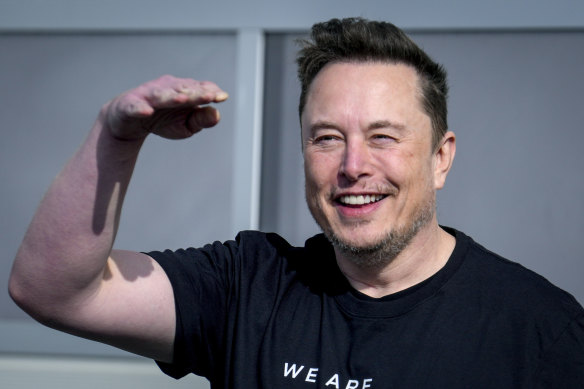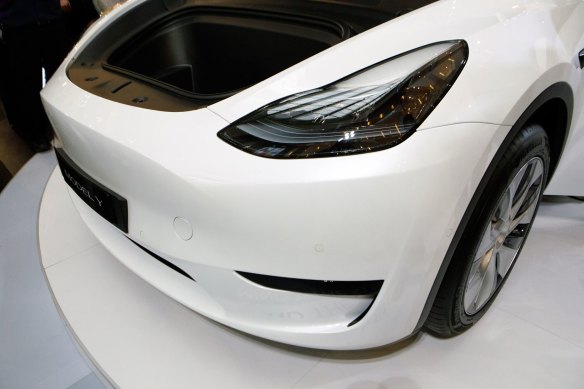Opinion
Betting on autonomy: Investors are waiting for Tesla’s future to arrive
Stephen Bartholomeusz
Senior business columnistTesla’s earnings might be $US1.2 billion ($1.8 billion) lower than a year ago amid slowing growth of the electric vehicle market, but that doesn’t seem to faze Elon Musk and his investors.
Tesla’s share price tumbled in aftermarket trade after the electric carmaker reported a 45 per cent slump in profit for the June quarter, missing analysts’ forecasts for the fourth consecutive quarter. However, its share price is still more than 70 per cent above its low point this year.

Elon Musk is asking shareholders to sit tight as his company is evolving.Credit: AP
In an indication of how tough conditions are for EV makers, while Tesla increased revenue by 2 per cent to $US25.5 billion, its earnings slumped from $US2.7 billion to $US1.5 billion and its profit margin shrunk from 9.6 per cent to 6.3 per cent.
In contrast, General Motors, which makes all its money from selling internal combustion vehicles and loses money on its EVs, easily beat analysts’ expectations in the June quarter. Its earnings, also released on Tuesday, were up 37 per cent to $US4.4 billion and its profit margin was 6.5 per cent.
GM shares trade on a multiple of its prospective earnings of about six. Tesla’s trade at more than 100 times its expected earnings. At face value, that makes no sense.
It can only be rationalised if investors see Tesla as something other than what it is – an automaker operating in a still fast-growing but increasingly competitive and increasingly low-margin niche of an otherwise mature industry.
Elon Musk has been able to successfully sell investors on his vision of what Tesla might be, rather than what it is today.
If it were valued as a carmaker, Tesla would be worth a fraction of its current $US785 billion market capitalisation, which is massively below the $US1.2 trillion it was valued at less than three years ago.
Despite regularly failing to meet expectations, whether financial or related to its products, Elon Musk has been able to successfully sell investors on his vision of what Tesla might be rather than what it is today.
In his mind, Tesla is an artificial intelligence company, and its future (and its value) isn’t in the vehicles it makes, or even the large-scale batteries that are generating a growing stream of profits, but software the company is developing for autonomous self-driving vehicles and humanoid robots.
It is robotaxis and Tesla’s Optimus robot – the former a cross between Uber and Airbnb, and the latter a robotic workforce for performing mundane or dangerous tasks within factories – that are Tesla’s future, according to Musk.

Tesla is more than just a carmaker, according to its billionaire chief executive Elon Musk.Credit: Bloomberg
“If somebody doesn’t believe Tesla is going to solve autonomy, I think they should not be an investor in the company,” Musk said on Tuesday’s earnings call. He has said previously that if Tesla does solve autonomy, it would be a $US30 trillion company.
Investors were scheduled to receive a better insight into the robotaxi plan at a presentation next month. However, Musk says he wants to make some design changes, so the presentation has been deferred until October.
Optimus, which is already performing some tasks in one of Tesla’s plants, is scheduled to be available for purchase in 2026.
The robotaxi fleet is dependent on Tesla solving autonomy and then gaining regulatory approval to roll out the self-driving vehicles, which will be no easy feat. GM announced on Tuesday that it had halted work on its Cruise autonomous vehicle because of regulatory uncertainty.
Musk has, it should be said, been spruiking the potential of robotaxis for the best part of a decade, but getting wheels on the road still appears to be a distant target.
‘If somebody doesn’t believe Tesla is going to solve autonomy, I think they should not be an investor in the company.’
Elon Musk
While investors wait for Tesla’s future to arrive, it remains just an automaker within a global market where the growth rate of the take-up of EVs, while still relatively strong, has slowed from the initially very high levels, and where so much new production capacity has poured into the market, particularly from China, that prices seem to be continuously falling.
Tesla, which was the sector’s pioneer, is close to being overtaken by China’s BYD as the world’s best-selling EV brand. Its market share in the US (where China’s EVs have been “tariffed” out of the country) has just dropped below 50 per cent, as conventional carmakers such as GM and Ford ramp up their EV production and sales.
Tesla has had several rounds of price cuts, both for its vehicles and its self-driving software. In response to tightening market conditions, it cut about 10 per cent of its workforce earlier this year.
But its existing line-up, apart from the niche and controversial Cybertruck, is stale. The long-promised low-cost $US25,000 mass-market EV, dubbed Model 2, has yet to emerge and appears to have been relegated to the sidelines while Musk focuses on the robotaxis. He now says production of the Model 2 might start in the first half of next year.
Given that Tesla is still an EV company, Musk could be expected to be worried about the prospect of Donald Trump regaining the US presidency and following through on his threat to end the Biden administration’s “EV mandate”.
“I will end the electric vehicle mandate on day one, thereby saving the US auto industry from complete obliteration, and saving US customers thousands of dollars per car,” Trump said earlier this month.
Musk seems unconcerned, believing that Tesla, which is profitable and doesn’t rely on tax credits for EVs as much as its domestic competitors, would be relatively better off if Trump withdrew federal government support for the sector.
The removal of the incentives and the winding back of federal carbon emission standards might also encourage conventional automakers to focus on their internal combustion models.
That might be why Musk said he would contribute $US45 million a month to Trump’s campaign, although there are US reports that he has backed away from that.
Perhaps that’s because Tesla’s sales in California – EV and Democratic Party heartland – dropped more than 24 per cent in the June quarter.
Or maybe he’s thought through the impact of some of Trump’s other policies, like a tariff on imports from Mexico. Tesla announced on Tuesday that it was halting the construction of a factory in Mexico, with Musk relating the decision directly to the prospect of Trump’s proposed tariffs.
Tesla’s business in China, about a third of its sales, would also be under even more pressure than it already is (because of the overcapacity and discounting within China’s domestic market) if Trump imposed the 60 per cent tariff rate he says he will impose on all China’s exports to the US. China will inevitably retaliate, and US companies operating within China, particularly known Trump supporters, could be an obvious target.
Given the industry’s circumstances, Musk and the true believers in his company really do need to believe that Tesla can solve autonomy. The quicker, the better.
The Business Briefing newsletter delivers major stories, exclusive coverage and expert opinion. Sign up to get it every weekday morning.